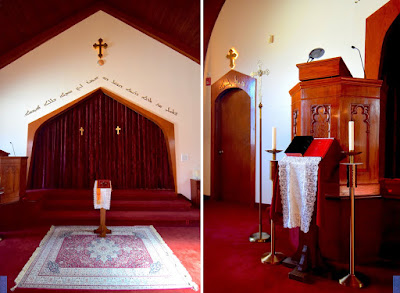On the Mysteriological Theology of the Church of the East
 |
| The Late Patriarch of the Church of the East, Mar Dinkha IV |
By Bp. Joseph Boyd (Ancient Church of the West)
In the far eastern church of Persia and India, the Assyrian Church of the East, which developed from Jewish Christianity in Edessa and Nisibis, formed the Patriarchate of Babylon and created a different understanding of Eucharistic theology than that which was developed in the West. In the East, the iconic and mysteriological function of covenantal “anamnesis”, baptismal and eucharistic life that was lived within the community of faith, was understood as something that did not require Aristotelian philosophy of nature and accidents.
“Lofty, in truth, and exalted is this mystery that the priest performs in the midst of the sanctuary mystically. Mystically the Church depicts the glorious Mysteries; and as by an image she shews to all men those things that have come to pass. Those things which came to pass is the death of the Son she commemorates by the Mysteries; His resurrection also from the dead she reveals before all. A mystery mystically shews that which has come to pass and that which is to come about: but the Church shews mystically in her Mysteries only that which has come to pass.” – Mar Narsai the Great, (d. 502) Homily XVII, An Exposition on the Mysteries (Quoted within “Mysteries of the Kingdom”, Mar Awa Royel, p. 290)
 |
| The Common Architectural Layout of the Assyrian Church |
The Syriac understanding of “Raza”, which is what the Church of the East calls the Sacraments, is not the same thing as “Mysterion” in Greek. The Greek has very clear, subtle definitions. The Syriac was intentionally unclear. It obscures, rather than makes subtly and philosophical explicit. This is also shown in the multiple veils used in the sacraments. The gifts are veiled. Incense is used as a veil, or a covering, as it was in the Old Testament. The “Holy of Holies” is veiled for sacramental action, and the whole interaction with the sacramental aspect of the church is “otherized” – It is set outside of comprehension and made apart to represent a God who cannot be comprehended or defined. It is very much in line with the ancient Hebrew way of interacting with the sacred. But, this culture is hard to communicate, because it is a lived experience, emotionally comprehended, so the Church of the East ends up using negatory language to counterpoint Roman theological language.
 |
| Eucharistic Veils in the Indian Syriac Style, Influenced by Both the Church of the East and the Syriac Orthodox Church |
Such a theology is both interesting and relevant to discussions today, as traditional philosophical language has begun to fall apart under Postmodern deconstruction, and insists on a marriage of Roman Cataphatic theology and Orthodox Apophatic Theology, united in the Gospel Narrative itself. The language used by the Fathers often employs analogies. These analogies harden over time and people take them literally, rather than remembering their analogous function. Different communities use different analogies in their different languages, and theology develops divergently across time and space. This process challenges our understanding of a universal, unchanging truth, and leads to great debates and divisions between various local, catholic churches. These debates are difficult to reconcile, and must be counteracted by an active process of discerning and returning to the original paradigms of Revealed Truth, learning from their history of use and change, and re-appropriating these ancient ideas into new contexts, always careful to be faithful to their historical development in the Church and not adding our own interpretive gloss. Such a theology becomes a rich tapestry of historic, patristic consensus, rather than a battlefield of unresolved conflicts.
In the conciliar process of the Church, the Church of the East provides a baseline, allowing us to see how the various cultures have developed and defined the understanding of God’s sacraments upon their original cultural and linguistic context. Theology and analogies are important, but they only aid the narrative, not assume it or overwhelm it. Sacraments always serve the Gospel, explicating the Story of Redemption in every context and every age, making present the finished work of Jesus Christ through the operation of the Holy Spirit.
In the conciliar process of the Church, the Church of the East provides a baseline, allowing us to see how the various cultures have developed and defined the understanding of God’s sacraments upon their original cultural and linguistic context. Theology and analogies are important, but they only aid the narrative, not assume it or overwhelm it. Sacraments always serve the Gospel, explicating the Story of Redemption in every context and every age, making present the finished work of Jesus Christ through the operation of the Holy Spirit.
I believe that this is why the study of the Syriac Christian Tradition is so important to Western Christians today, especially those from an Anglican background. We have much to learn from the East, and we must be in continuous process of reconciling with our brothers and sisters, asking for the Holy Spirit to reveal His Truth, and learning from one another in mutual submission and love. By doing this, we submit to the conciliar mind of the whole Church, both East and West, and bring balance to our cultural biases, which often cloud our understanding of the original context of the Gospel.
 |
| The Holy of Holies Behind the Veil |



Comments
Post a Comment